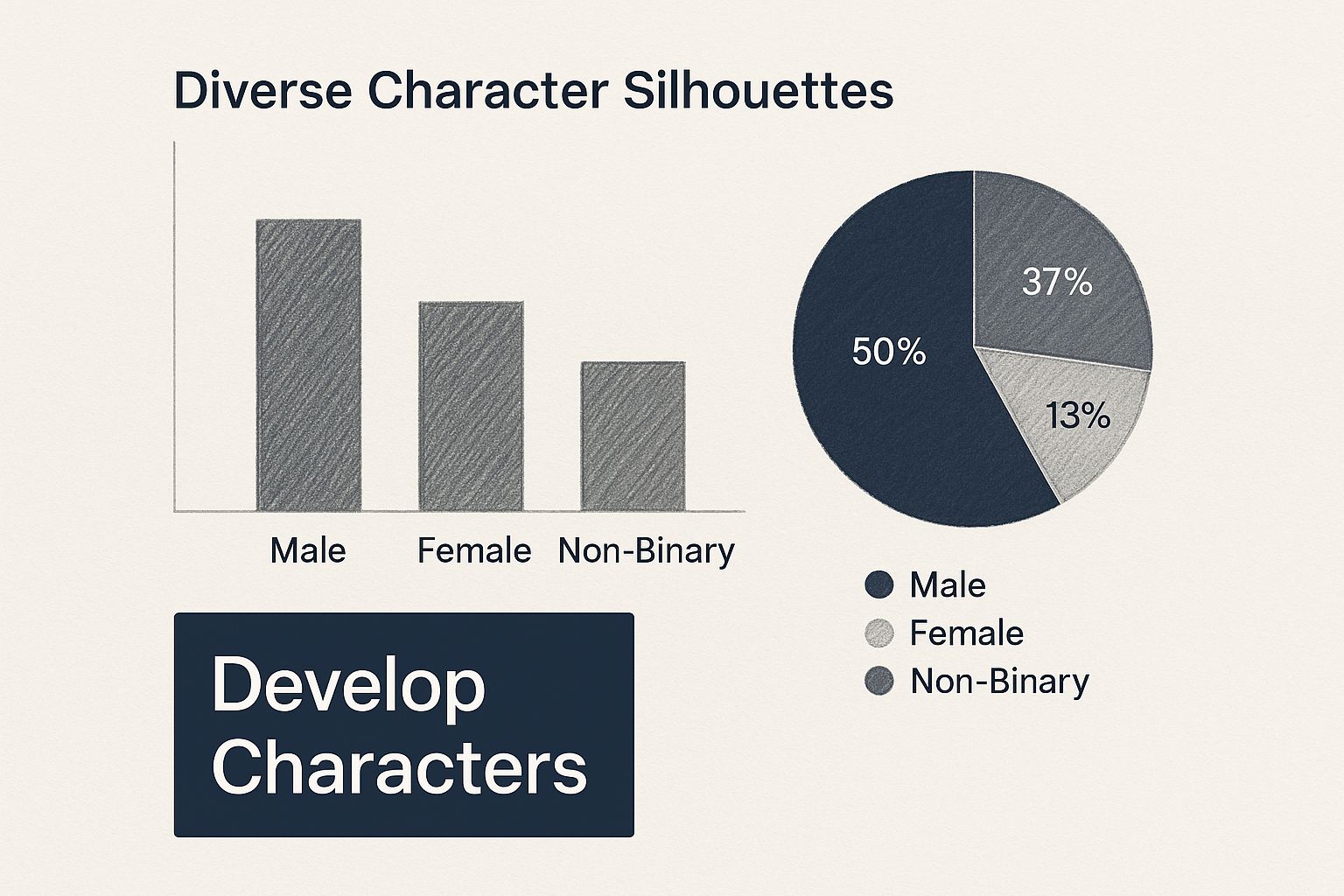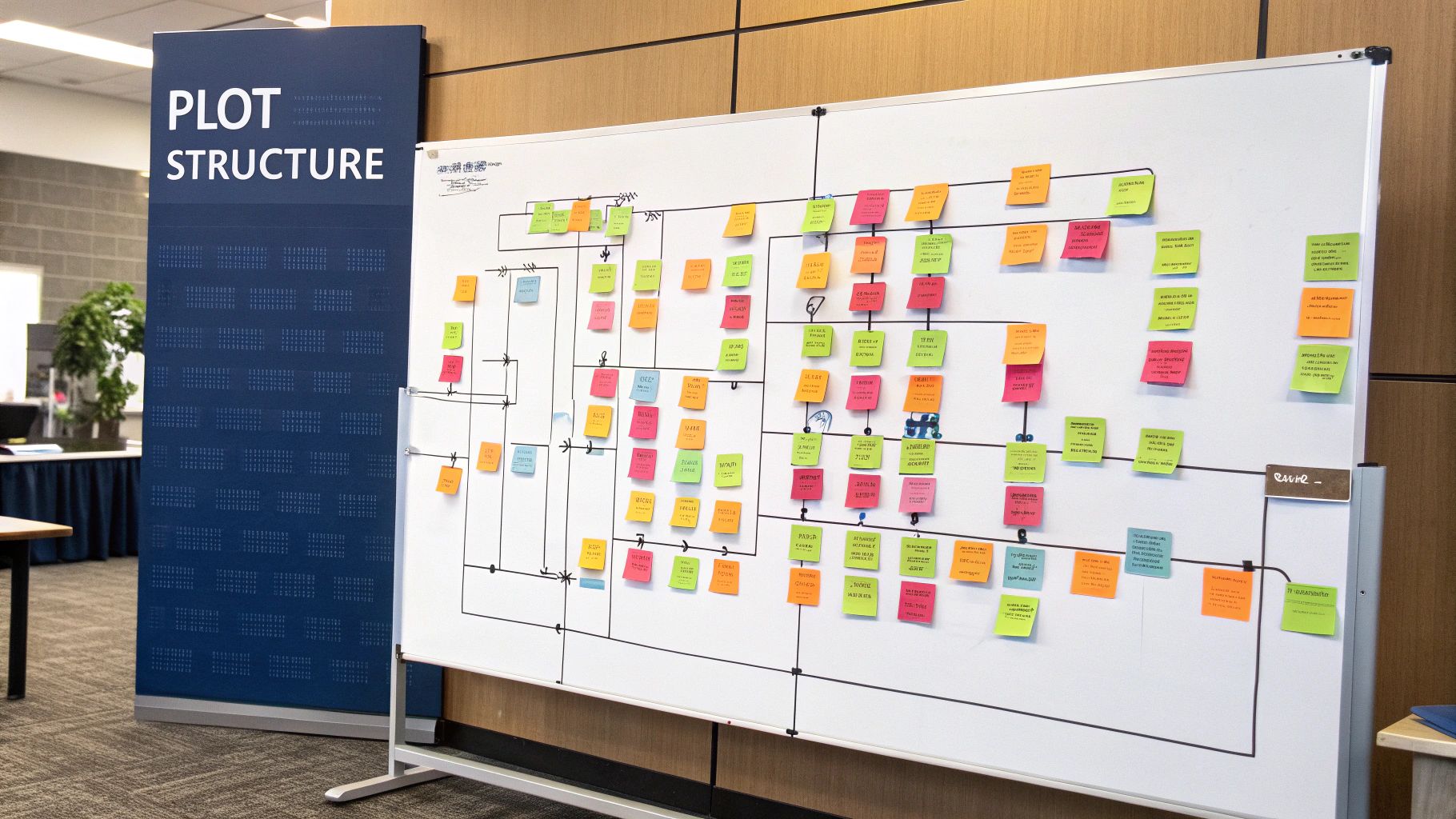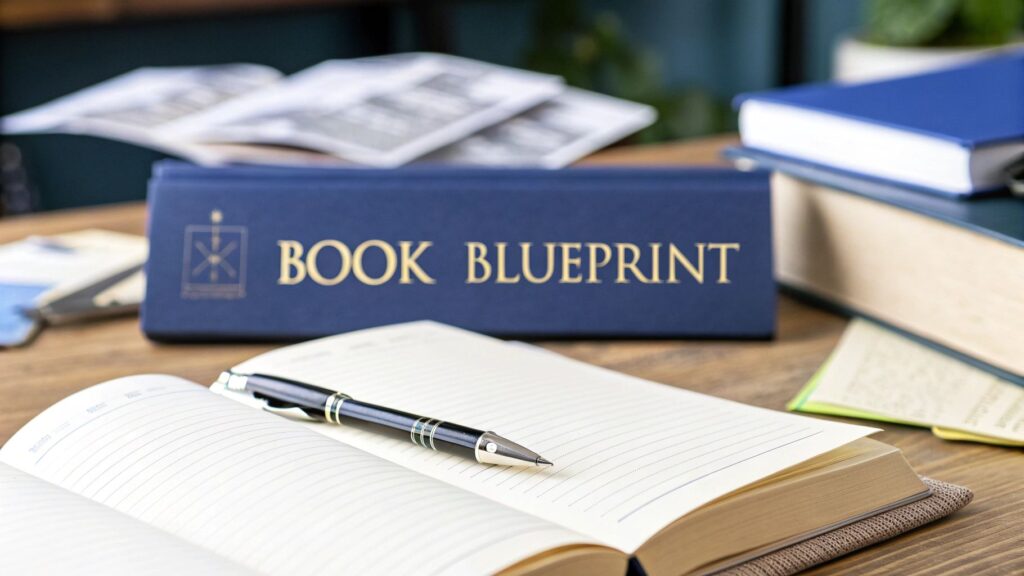Think of your book outline as your creative roadmap. It’s the process of taking your core idea—that brilliant spark of a story—and building a solid framework around it. You'll start by capturing your entire story in a single, powerful sentence. From there, you'll choose a structure, like the classic Three-Act or the detailed Snowflake Method, to map out the major turning points. This creates a flexible guide that helps you write with purpose, not a rigid set of rules that kills your creativity.
Why Your Book Outline Is Your Creative Roadmap

I’ve heard countless writers worry that a detailed plan will somehow extinguish their creative fire. In my experience, the exact opposite is true. A good outline is your story’s blueprint. It harnesses the power of structure in writing not to confine you, but to give you the confidence to build something truly magnificent.
It’s your low-risk testing ground. Before you pour hundreds of hours into a first draft, your outline lets you kick the tires on your core concepts. Is that shocking plot twist you dreamed up actually earned? Is your protagonist’s motivation flimsy or rock-solid? The outline is where you find and fix these foundational cracks before they can bring the whole house down.
Build Momentum and Beat Writer’s Block
So many people believe writing relies on random bolts of inspiration. The truth? Writing is about building and sustaining momentum. An outline is the engine for that momentum, breaking down the overwhelming task of writing a novel into a series of achievable, chapter-sized goals. It's so much easier to get to work when you know exactly what you need to tackle next.
This clarity is your secret weapon against writer’s block. Instead of facing a terrifyingly blank page, you have a map. You simply look at your plan, see the next step, and start writing. It turns that feeling of being overwhelmed into clear, actionable tasks that keep your story moving forward.
An outline is your story’s first draft—a place to experiment, make mistakes, and discover the true shape of your narrative before committing to the prose. It’s where you build the confidence to write freely and with purpose.
A Professional Approach to Publishing
An outline isn't just a creative tool; it's a powerful signal of professionalism. The numbers back this up. Authors who use detailed outlines are 30% more likely to finish their manuscripts on schedule. Even more telling, a recent survey revealed that 78% of literary agents see a clear outline as a sign of a well-prepared author, making them far more likely to consider a submission.
When an agent or editor sees a solid outline, they see a writer who understands their craft. It proves you’ve thought through the entire narrative arc, from pacing and character development to plot mechanics. It’s not just a document for you—it’s a clear message to the industry that you know how to build a story that works.
Finding an Outlining Method That Works for You

Before we dive into specific methods, take a look at the image above. It’s a great reminder that no matter which outlining style you pick, character development is at its heart. A solid outline doesn't just map out what happens; it builds the scaffolding for characters who feel real and drive the story with their choices.
Deciding how to write a book outline is a deeply personal journey. There’s no single "right" way to do it. Think of outlining methods less like strict rules and more like frameworks you can adapt to your own creative process.
The goal isn't to find a perfect system but to discover one that gives you enough structure to feel confident without stifling your creativity. For some writers, the entire book writing process is built around a single, trusted method they use for every book. Your job is to experiment and find what clicks.
Choosing the right approach depends entirely on your personality and the kind of story you're telling. Some writers thrive on meticulous planning, while others need the freedom to discover the story as they go. Let's explore a few popular methods to see which one might be the best fit for you.
Comparing Book Outlining Methods
This table breaks down some popular outlining methods to help you choose the best fit for your writing style.
| Method | Best For | Key Feature |
|---|---|---|
| The Snowflake Method | Planners who like to build a story from a single core idea outward. | Starts with a one-sentence summary and iteratively adds layers of detail. |
| The Three-Act Structure | Writers who want a classic, cinematic feel with strong pacing. | Divides the story into a clear Beginning (Setup), Middle (Confrontation), and End (Resolution). |
| The Book-End Method | Those who know their beginning and ending but need to figure out the middle. | Involves writing the first and last chapters first, then working inward to connect them. |
| Mind Mapping | Visual thinkers and "pantsers" who want structure without linearity. | Creates a non-linear, visual web of ideas, characters, and plot points. |
Each method offers a unique pathway from idea to finished manuscript. The key is to pick the one that feels the most intuitive and empowering for your project.
The Snowflake Method for Planners
Do you love starting with one brilliant kernel of an idea and watching it blossom into something complex and layered? If so, the Snowflake Method might be your new best friend. It’s a fantastic process for writers who want to build their story from the ground up, starting small and gradually adding detail.
It all begins with a single sentence that encapsulates your entire story. From there, you expand it into a paragraph. Then you write a one-page summary for each main character. You keep expanding—a synopsis of the plot, detailed character charts, and eventually, a scene-by-scene spreadsheet. It’s a planner’s dream.
This method truly shines with complex novels full of intricate plots and subplots, as it forces every new element to tie back to that central concept. Your one-sentence summary—something like, "A disgraced knight must team up with a rogue sorceress to find a mythical artifact before an ancient evil consumes the kingdom"—becomes the DNA of your entire book.
The real beauty of the Snowflake Method is its scalability. You can stop at any point. If a four-page summary gives you enough confidence to start writing, great. If you need a 50-page, scene-by-scene breakdown, the method supports that too.
The Classic Three-Act Structure
Borrowed straight from screenwriting, the Three-Act Structure is a timeless framework that has powered compelling stories for generations. Its strength lies in creating powerful pacing and momentum, ensuring your story has a distinct beginning, a tense middle, and a deeply satisfying conclusion. It’s perfect for giving your book a cinematic feel.
The structure is simple but incredibly effective:
- Act I: The Setup — Here, you introduce your protagonist and their world. It all leads to an inciting incident, that one moment that kicks off the main story and throws your character's life off balance.
- Act II: The Confrontation — This is the meat of your story. Your hero faces escalating obstacles and challenges, pushing them to their limits. It contains a critical midpoint, a major twist or revelation that raises the stakes dramatically.
- Act III: The Resolution — The final act builds to a thrilling climax where the central conflict is finally confronted and resolved. This is followed by a short resolution showing the aftermath and your character’s new normal.
This structure is a reliable go-to for almost any genre because it provides a powerful roadmap for your story's emotional journey. It forces you to think about the major turning points, which keeps the plot from getting lost or wandering aimlessly.
Building Your Story's Foundation

Now that you have a method in mind, it's time to get your hands dirty and start building the actual skeleton of your story. Think of these next elements as the architectural pillars that will hold up your entire narrative. Before you even think about chapters and scenes, you need to lock down the core components that make a story stick with a reader long after they’ve finished.
This is where you translate that big, exciting idea into something tangible. If you find yourself staring at a blank page, it might be a good time to look for some creative tips to spark your creativity and generate ideas effectively. Sometimes, a little jolt of inspiration is all it takes to distill your concept into something truly powerful.
From Premise to a Powerful Logline
Every great story, at its heart, starts with a compelling "what if?" This is your premise. It’s the raw, conceptual core of your book. For instance, "What if a reclusive chocolatier invites five children to his magical factory?"
From that spark, you’ll want to craft a logline. This is a tight, one-to-two-sentence summary that nails down the protagonist, their goal, and the main conflict they're up against. A solid logline isn't just for you; it's a fantastic tool for pitching your book down the road. Getting this right from the start gives your outline a clear, unwavering direction.
Developing Characters Who Drive the Plot
Let’s be clear: your characters are the engine of your story. It’s their wants, their flaws, and their decisions that push the narrative from one page to the next. Spend real time developing rich character profiles that go way beyond hair color and height.
What are their deepest fears? What past trauma shaped their worldview? What do they want more than anything in the world, and what are they willing to sacrifice to get it? You can see how these details play out in a full structure by looking at this helpful https://barkerbooks.com/book-outline-example/. The better you know your characters, the more authentic their actions will feel to the reader.
Your plot is what happens; your characters are why it happens. A weak character can make even the most exciting plot feel hollow. Invest time here, as it will pay dividends in every chapter you write.
This isn't just a modern trend. In my experience, and backed by historical data, about 70% of professional writers consider this foundational work non-negotiable for completing a manuscript. This has been a core principle in writing programs for decades, all to ensure stories are coherent and complex plots don't fall apart.
Mapping Your Narrative Turning Points
With your characters fleshed out, the next step is to map out the major turning points of their journey. These are the big, unmissable moments that define your story’s structure.
- The Inciting Incident: This is the event that shatters your protagonist's normal life and throws them into the story.
- The Midpoint: A major twist or revelation smack in the middle of the book. It raises the stakes and often changes the hero's understanding of the conflict.
- The Climax: The final, high-stakes confrontation where the main conflict comes to a head and is resolved, for better or worse.
These three points create the primary arc of your narrative. From there, you can weave in subplots—those smaller, secondary storylines, often centered on supporting characters—to add layers of depth and make your world feel much richer and more expansive.
Bringing Your Chapters and Scenes to Life
Okay, you've got the big-picture architecture of your story figured out. Now it's time to get your hands dirty with the details. We're moving from the high-level blueprint to the room-by-room design plan. This is where we flesh out the individual chapters and scenes that will become the living, breathing heart of your book.
Learning how to write a book outline at this granular level is all about making sure every single chapter has a reason to exist. If a chapter doesn't move the story forward, reveal something critical about a character, or crank up the tension, it’s just taking up space. You want every page to earn its place.
Defining Each Chapter's Job
Every chapter needs a job. A single, clear purpose. Before you start breaking it down into scenes, ask yourself a simple question: What is the one thing that must happen here? This becomes the chapter's guiding principle.
For instance, your chapter’s mission might be: "Introduce the antagonist and show their power by having them defeat the hero's mentor." That single sentence gives you a laser focus. Now, every scene you map out for that chapter has to serve that one goal. This simple trick is what stops chapters from meandering and keeps your narrative drive strong.
A little trick I swear by is something I call "Reverse Outlining", which I normally use in the editing phase. The idea works beautifully here, though. After you've listed out the scenes for a chapter, look back and ask, "Does this group of scenes actually accomplish what I set out to do?" If the answer is no, you know exactly what needs to be cut or rethought.
Mapping Scene by Scene
Once you know a chapter’s main goal, you can start breaking it down into scenes. Think of a scene as a self-contained unit of story happening in a single time and place. For each scene, I find it incredibly helpful to jot down just a few key details.
- Point of View (POV): Who is telling this part of the story? Through whose eyes will the reader experience it?
- The Setting: Where are we? When is it? A quick note like, "Rainy alley behind the nightclub, 3 AM," is perfect.
- Core Event: What literally happens? Keep it brief. "Protagonist corners the informant; gets a cryptic clue just before the informant is snatched."
- Emotional Shift: How does the POV character feel at the start versus the end of the scene? This is crucial for tracking their internal arc.
This might feel like a lot of prep work, but trust me, it’s the secret sauce that turns a vague concept into a concrete roadmap for your writing sessions. It helps you control the pacing, letting you balance those big, explosive action scenes with the quiet moments of character development that make readers care. This detailed, scene-by-scene plan is the final bridge between your grand idea and getting those first words down on the page.
Choosing the Right Outlining Tools
Your book outline isn't something you carve in stone; it’s a living, breathing document. Because of that, you need tools that can evolve right along with your story. I’ve seen countless writers try to wrestle their plot into a single Word document or a precarious stack of index cards, and it often turns the creative process into a chore. The right software, however, can feel like a genuine partner, helping you visualize your plot, track complex character arcs, and rearrange entire scenes with a simple drag-and-drop.
The trick is to find a tool that clicks with how you think. Some of us thrive in a dedicated writing environment, while others need the visual freedom of project management apps. Your goal is to find software that makes building and refining your outline feel intuitive, not like you're fighting the technology.
Dedicated Writing and Outlining Software
For so many authors I've worked with, specialized programs like Scrivener or Plottr are absolute game-changers. These aren't just fancy word processors; they're complete writing studios built from the ground up for long-form projects.
They get that a book is a collection of many interconnected parts. You can create virtual index cards for every scene, lay out your entire plot on a timeline, and keep all your research, character sketches, and chapter drafts neatly organized in one project file. This integrated approach is a massive leap forward when you're trying to build an outline that can support a complex story.
Just look at the interface of a powerful tool like Scrivener. It combines your manuscript, research, and outline all in one view.
See that "binder" on the left? That’s where the magic happens. It lets you jump between chapters and scenes instantly, making it incredibly easy to restructure your entire book on the fly.
Flexible Tools for Visual Thinkers
What if dedicated writing software feels too restrictive? Don't worry, you have other fantastic options. I’ve seen writers find incredible success with visual project management tools that, while not built for authors, work beautifully for outlining.
- Trello or Asana: These platforms use a card-based system, which is perfect for creating a virtual storyboard. You can make a "card" for each chapter or scene and then just drag them around to experiment with different story structures and pacing.
- Mind Mapping Software: If you're a non-linear thinker, apps like XMind or Miro can be a godsend. You start with your core idea and branch out with characters, plot points, and themes, creating a visual web of your story's DNA. It's a fantastic way to see how everything connects.
The global book market, valued at a staggering USD 150.99 billion in 2024, is being reshaped by these digital workflows. In fact, data from North America shows that over 75% of writers now use some form of software to outline—a testament to how essential these tools have become. You can dig into more market insights on Mordor Intelligence.
Beyond just outlining, many successful authors go a step further by setting up a 'second brain' with dedicated apps. This helps them capture and connect all their sprawling research and stray story ideas.
Ultimately, the best tool is the one that gets out of your way and lets the ideas flow. And remember, your outline is just one piece of the puzzle. Once your book is finally written, you'll need a whole new strategy, which is why you might find our guide on how to promote your book helpful for that next step.
Answering Your Biggest Book Outlining Questions
No matter how prepared you are, you're bound to hit a few snags or have questions pop up while you're outlining. Honestly, that's a good sign—it means you're really digging into your story's architecture. Let's walk through some of the most common questions I hear from writers so you can get unstuck and back to building your book with confidence.
How Detailed Does My Outline Really Need to Be?
This is the big one, isn't it? The good news is, there’s no right answer, only what’s right for you. An outline's only job is to give you enough direction to write your next scene without feeling like you're lost in the woods.
Some writers are true "plotters." They thrive on incredibly detailed, multi-page outlines that map out every scene, every character beat, and even bits of dialogue. This approach gives them an exhaustive roadmap, which can be a huge comfort.
On the other end of the spectrum are the "pantsers," who find that level of detail stifling. They might just want a single page with the big-picture plot points and a clear ending. This gives them a destination but leaves the journey wide open for discovery.
The perfect outline is a personal choice. I always suggest starting with the core pillars of your story—the inciting incident, the midpoint, and the climax. From there, keep adding layers of detail, chapter by chapter, until you find that sweet spot where you feel both guided and free.
What if I Get a Great Idea That Isn't in My Outline?
First off, that's fantastic! New ideas are proof that your creative mind is working overtime. Your outline is a guide, not a contract carved in stone. The second it starts holding you back instead of helping you forward is the moment you should change it.
When inspiration strikes, don't just force the new idea in. Step back and look at your outline from a high level.
- Does this new idea solve a problem or replace a weaker plot point you were already wrestling with?
- Will it make a character's motivation stronger or introduce a much more interesting conflict?
- Think about the ripple effect—how does it change the scenes that follow?
A flexible outline is a strong outline. Some of the best stories come from those unexpected flashes of brilliance that force you to pivot. Listening to your story as it takes shape is what separates a good book from a truly great one.
Can I Use an Outline for a Memoir or Nonfiction Book?
Absolutely. In fact, for nonfiction, I'd argue that a solid outline is even more critical. It serves the exact same purpose as it does in fiction: creating a logical and engaging path for your reader. The only difference is the raw material you're working with.
For a memoir, you're not just listing life events chronologically. You're arranging them around specific themes or a central emotional journey. Your outline helps you build narrative tension and deliver those powerful emotional payoffs, much like in a novel.
For an instructional nonfiction book, think of your outline as the syllabus for a course. You need to introduce concepts in a logical order, with each chapter building on the last. This structure is what ensures your reader can easily follow along, absorb the information, and actually put your advice to use.
I'm a "Pantser." Do I Really Have to Outline?
Even if you're a proud "pantser" who loves writing by the seat of your pants, a bare-bones outline can be an incredible safety net. You'd be surprised how many successful pantsing authors, like Stephen King, don't just write into a black hole. They usually have a core premise and a vague sense of where they're heading.
I recommend trying what I call a "landmark" outline.
Instead of planning every single step of the journey, just define the major destinations on your story's map:
- The Starting Point: What kicks everything off?
- The Midpoint: The big twist or the point of no return.
- The Destination: How does it all end?
This gives you just a few signposts to aim for, which can keep your story from wandering off into the weeds. It’s the perfect middle ground, offering just enough structure to provide direction while leaving all the room you need for that magic of discovery.
